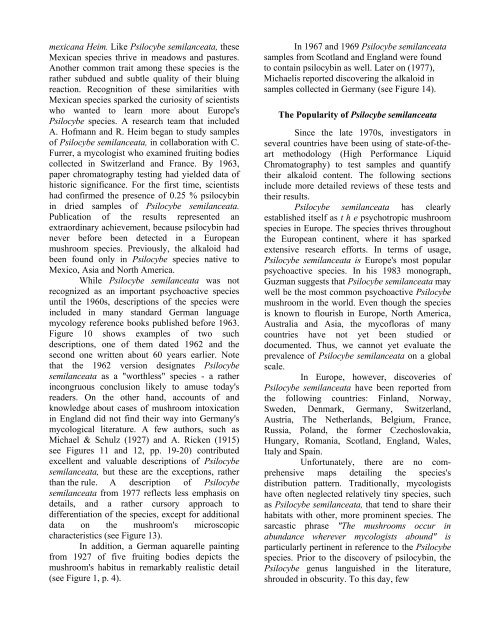Jochen Gartz - Magic Mushrooms Around the ... - preterhuman.net
Jochen Gartz - Magic Mushrooms Around the ... - preterhuman.net
Jochen Gartz - Magic Mushrooms Around the ... - preterhuman.net
Create successful ePaper yourself
Turn your PDF publications into a flip-book with our unique Google optimized e-Paper software.
mexicana Heim. Like Psilocybe semilanceata, <strong>the</strong>se<br />
Mexican species thrive in meadows and pastures.<br />
Ano<strong>the</strong>r common trait among <strong>the</strong>se species is <strong>the</strong><br />
ra<strong>the</strong>r subdued and subtle quality of <strong>the</strong>ir bluing<br />
reaction. Recognition of <strong>the</strong>se similarities with<br />
Mexican species sparked <strong>the</strong> curiosity of scientists<br />
who wanted to learn more about Europe's<br />
Psilocybe species. A research team that included<br />
A. Hofmann and R. Heim began to study samples<br />
of Psilocybe semilanceata, in collaboration with C.<br />
Furrer, a mycologist who examined fruiting bodies<br />
collected in Switzerland and France. By 1963,<br />
paper chromatography testing had yielded data of<br />
historic significance. For <strong>the</strong> first time, scientists<br />
had confirmed <strong>the</strong> presence of 0.25 % psilocybin<br />
in dried samples of Psilocybe semilanceata.<br />
Publication of <strong>the</strong> results represented an<br />
extraordinary achievement, because psilocybin had<br />
never before been detected in a European<br />
mushroom species. Previously, <strong>the</strong> alkaloid had<br />
been found only in Psilocybe species native to<br />
Mexico, Asia and North America.<br />
While Psilocybe semilanceata was not<br />
recognized as an important psychoactive species<br />
until <strong>the</strong> 1960s, descriptions of <strong>the</strong> species were<br />
included in many standard German language<br />
mycology reference books published before 1963.<br />
Figure 10 shows examples of two such<br />
descriptions, one of <strong>the</strong>m dated 1962 and <strong>the</strong><br />
second one written about 60 years earlier. Note<br />
that <strong>the</strong> 1962 version designates Psilocybe<br />
semilanceata as a "worthless" species - a ra<strong>the</strong>r<br />
incongruous conclusion likely to amuse today's<br />
readers. On <strong>the</strong> o<strong>the</strong>r hand, accounts of and<br />
knowledge about cases of mushroom intoxication<br />
in England did not find <strong>the</strong>ir way into Germany's<br />
mycological literature. A few authors, such as<br />
Michael & Schulz (1927) and A. Ricken (1915)<br />
see Figures 11 and 12, pp. 19-20) contributed<br />
excellent and valuable descriptions of Psilocybe<br />
semilanceata, but <strong>the</strong>se are <strong>the</strong> exceptions, ra<strong>the</strong>r<br />
than <strong>the</strong> rule. A description of Psilocybe<br />
semilanceata from 1977 reflects less emphasis on<br />
details, and a ra<strong>the</strong>r cursory approach to<br />
differentiation of <strong>the</strong> species, except for additional<br />
data on <strong>the</strong> mushroom's microscopic<br />
characteristics (see Figure 13).<br />
In addition, a German aquarelle painting<br />
from 1927 of five fruiting bodies depicts <strong>the</strong><br />
mushroom's habitus in remarkably realistic detail<br />
(see Figure 1, p. 4).<br />
In 1967 and 1969 Psilocybe semilanceata<br />
samples from Scotland and England were found<br />
to contain psilocybin as well. Later on (1977),<br />
Michaelis reported discovering <strong>the</strong> alkaloid in<br />
samples collected in Germany (see Figure 14).<br />
The Popularity of Psilocybe semilanceata<br />
Since <strong>the</strong> late 1970s, investigators in<br />
several countries have been using of state-of-<strong>the</strong>art<br />
methodology (High Performance Liquid<br />
Chromatography) to test samples and quantify<br />
<strong>the</strong>ir alkaloid content. The following sections<br />
include more detailed reviews of <strong>the</strong>se tests and<br />
<strong>the</strong>ir results.<br />
Psilocybe semilanceata has clearly<br />
established itself as t h e psychotropic mushroom<br />
species in Europe. The species thrives throughout<br />
<strong>the</strong> European continent, where it has sparked<br />
extensive research efforts. In terms of usage,<br />
Psilocybe semilanceata is Europe's most popular<br />
psychoactive species. In his 1983 monograph,<br />
Guzman suggests that Psilocybe semilanceata may<br />
well be <strong>the</strong> most common psychoactive Psilocybe<br />
mushroom in <strong>the</strong> world. Even though <strong>the</strong> species<br />
is known to flourish in Europe, North America,<br />
Australia and Asia, <strong>the</strong> mycofloras of many<br />
countries have not yet been studied or<br />
documented. Thus, we cannot yet evaluate <strong>the</strong><br />
prevalence of Psilocybe semilanceata on a global<br />
scale.<br />
In Europe, however, discoveries of<br />
Psilocybe semilanceata have been reported from<br />
<strong>the</strong> following countries: Finland, Norway,<br />
Sweden, Denmark, Germany, Switzerland,<br />
Austria, The Ne<strong>the</strong>rlands, Belgium, France,<br />
Russia, Poland, <strong>the</strong> former Czechoslovakia,<br />
Hungary, Romania, Scotland, England, Wales,<br />
Italy and Spain.<br />
Unfortunately, <strong>the</strong>re are no comprehensive<br />
maps detailing <strong>the</strong> species's<br />
distribution pattern. Traditionally, mycologists<br />
have often neglected relatively tiny species, such<br />
as Psilocybe semilanceata, that tend to share <strong>the</strong>ir<br />
habitats with o<strong>the</strong>r, more prominent species. The<br />
sarcastic phrase "The mushrooms occur in<br />
abundance wherever mycologists abound" is<br />
particularly pertinent in reference to <strong>the</strong> Psilocybe<br />
species. Prior to <strong>the</strong> discovery of psilocybin, <strong>the</strong><br />
Psilocybe genus languished in <strong>the</strong> literature,<br />
shrouded in obscurity. To this day, few








![The Big Lie 9-11 and Government Complicity in Mass Murder [PDF]](https://img.yumpu.com/50957077/1/190x245/the-big-lie-9-11-and-government-complicity-in-mass-murder-pdf.jpg?quality=85)








